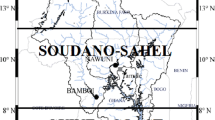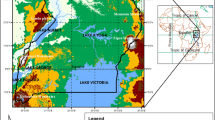Abstract
We present preliminary analyses of the historical (1986–2005) climate simulations of a ten-member subset of the Coupled Model Inter-comparison Project Phase 5 (CMIP5) global climate models over Southeast Asia. The objective of this study was to evaluate the general circulation models’ performance in simulating the mean state of climate over this less-studied climate vulnerable region, with a focus on precipitation. Results indicate that most of the models are unable to reproduce the observed state of climate over Southeast Asia. Though the multi-model ensemble mean is a better representation of the observations, the uncertainties in the individual models are far high. There is no particular model that performed well in simulating the historical climate of Southeast Asia. There seems to be no significant influence of the spatial resolutions of the models on the quality of simulation, despite the view that higher resolution models fare better. The study results emphasize on careful consideration of models for impact studies and the need to improve the next generation of models in their ability to simulate regional climates better.







Similar content being viewed by others
References
ADB (2009) The economics of climate change in Southeast Asia: A regional review. Mandaluyong, Philippines
Brands S, Gutierrez JM, Herrera S, Cofino AS (2012) On the use of reanalyses data for downscaling. J Clim 25:2517–2526
Brekke L, Barsugli J (2012) Uncertainties in projections of future changes in extremes, in Extremes in a changing climate: Detection, Analysis and Uncertainty, edited by A. AghaKouchak et al. Springer, Dordrecht Heidelberg, New York, London, doi:10.1007/978-94-007-4479-011
Chang CP, Wang Z, McBride J, Liu CH (2005) Annual cycle of Southeast Asia maritime continent rainfall and the asymmetric monsoon transition. J Clim 18:287–301
Collins et al (2011) Development and evaluation of an Earth-System model-HadGEM2. Geosci Model Dev 4:1051–1075. doi:10.1175/JHM5601
Dommenget D, Latif M (2002) A cautionary Note on the interpretation of EOFs J Clim 15(2):216–225
Dufresne et al (2012) Climate change projections using the IPSL-CM5 Earth System Model: from CMIP3 to CMIP5. Clim Dyn. doi:10.1007/s00382-012-1636-1
Elguindi N, Giorgi F, Turuncoglu U (2014) Assessment of CMIP5 global model simulations over the subset of CORDEX domains used in the Phase I CREMA. Clim Chang 125:7. doi:10.1007/s10584-013-0935-9
Gent et al (2011) The community climate system model version 4. J Clim 24:4973–4991
Giannini A (2005) ENSO and the seasonal cycle of precipitation in Southeast Asia, available through:http://iricolumbiaedu/~mnorton/Indramayu/Climate%20background_SE%20Asia/Giannini_ENSO&SeasonalPrecipCycleSEApdf
Giorgi F, Mearns LO (2002) Calculation of average, uncertainty range, and reliability of regional climate changes from AOGCM simulations via the “Reliability Ensemble Averaging” (REA) method. J Hydrol 15:1141–1158
Gu H, Yu Z, Wang J, Ju Q, Yang C, Fan C (2014) Climate change hotspots identification in China through the CMIP5 global climate model ensemble. Adv Meteorol. doi:10.1155/2014/963196
Gu H, Yu Z, Wang J (2015) Assessing CMIP5 general circulation model simulations of precipitation and temperature over China Int. J Clim 35:2431–2440
Hannachi A (2004) A primer for EOF analysis of climate data, available at the website www.met.rdg.ac.uk/~han/Monitor/eofprimer.pdf
Harris I, Jones PD, Osborn TJ, Lister DH (2014) Updated high-resolution grids of monthly climatic observations—the CRU TS310 Dataset. Int J Climatol 25(3):623–642
Houghton JT, Ding Y, Griggs DJ, Nouger M, van der Linden PJ, Dai X, Maskell K, Johnson CA (2001) IPCC – Climate Change 2001: The Scientific Basis. Contribution of Working Group I to the third Assessment Report of the Intergovernmental Panel on Climate Change. Cambridge University Press, Cambridge
Huffman et al (2007) The TRMM Multisatellite Precipitation Analysis (TMPA): quasi-global multiyear, combined-sensor precipitation estimates at fine scales. J Hydrometeorol 8:38–55
Hurrell et al (2013) The community earth system model: a framework for collaborative research. Bull Am Meteorol Soc. doi:10.1175/BAMS-D-12–00121
IPCC (2007b) Climate Change 2007 – Impacts, Adaptation and Vulnerability Contribution of Working Group II to the Fourth Assessment Report of the IPCC ML Parry, OF Canziani, JP Palutikof, PJ van der Linden and CE Hanson, Eds Cambridge University Press, Cambridge, 976 pp
IPCC (2013) Climate Change 2013: The Physical Science Basis Contribution of Working Group I to the Fifth Assessment Report of the Intergovernmental Panel on Climate Change [Stocker, TF, D Qin, G-K Plattner, M Tignor, SK Allen, J Boschung, A Nauels, Y Xia, V Bex and PM Midgley (eds)] Cambridge University Press, Cambridge, United Kingdom and New York, NY, USA, 1535 pp
IPCC (2014) Climate Change 2014: Impacts, Adaptation, and Vulnerability Part A: Global and Sectoral Aspects Contribution of Working Group II to the Fifth Assessment Report of the Intergovernmental Panel on Climate Change [Field, CB, VR Barros, DJ Dokken, KJ Mach, MD Mastrandrea, TE Bilir, M Chatterjee, KL Ebi, YO Estrada, RC Genova, B Girma, ES Kissel, AN Levy, S MacCracken, PR Mastrandrea, and LL White (eds)] Cambridge University Press, Cambridge, United Kingdom and New York, NY, USA, 1132 pp
Juneng L, Tangang FT (2005) Evolution of ENSO-related rainfall anomalies in Southeast Asia region and its relationship with atmosphere-ocean variations in Indo-Pacific sector. Clim Dyn 25:337–350
Knutti R, Furrer R, Tebaldi C, Cermak J, Meehl GA (2010) Challenges in combining projections from multiple models. J Clim 23:2739–2756
Kripalani RH, Kulkarni A (1998) The relationship between some large scale atmospheric parameters and rainfall over Southeast Asia: a comparison with features over India. Theor Appl Clim 90:133–159
Kumar S, Merwade V, Kinter JL, Niyogi D (2013) Evaluation of temperature and precipitation trends and long-term persistence in CMIP5 twentieth-century climate simulations. J Clim 26:4168–4185
Liepert BG, Previdi M (2012) Inter-model variability and biases of the global water cycle in CMIP3 coupled climate models. Environ Res Lett. doi:10.1088/1748-9326/7/1/014006
Liew SC, Chia AS and Kwoh LK (2010) Spatio-temporal variability of precipitation in Southeast Asia analyzed using the empirical orthogonal function (EOF) Technique. Proc. IEEE 2010 International Geoscience and Remote Sensing Symposium (IGARSS’10), 26–30 July 2010, Honolulu, Hawaii, USA, pp. 4701–4704
Martin et al (2011) The HadGEM2 family of Met Office Unified Model climate configurations. Geophys Model Dev 4:723–757
Mehran A, AghaKouchak A, Phillips TJ (2014) Evaluation of CMIP5 continental precipitation simulations relative to satellite based gauge-adjusted observations. J Geophys Res:Atm. doi:10.1002/2013JD021152
Otieno VO, Anyah RO (2013) CMIP5 simulated climate conditions of the Greater Horn of Africa (GHA) part 1: contemporary climate. Clim Dyn 41:2081–2097
Raddatz TJ et al (2007) Will the tropical land biosphere dominate the climate-carbon cycle feedback during the twenty first century? Clim Dyn 20:565–574
Rotstayn LD, Jeffrey SJ, Collier MA, Dravitzki SM, Hirst AC, Syktus JI, Wong KK (2012) Aerosol-and greenhouse gas-induced changes in summer rainfall and circulation in the Australasian region: a study using single-forcing climate simulations. Atmos Chem Phys 12:6377–6404
Rupp DE, Abatzoglou JT, hegewisch KC, Mote PW (2013) Evaluation of CMIP5 20th century climate simulations for the Pacific Northwest USA. J Geophys Res. doi:10.1002/jgrd50843 2013
Schubert, SD, Lim YK (2013) Climate variability and weather extremes: model-simulated and historical data hydrologic extremes in a changing climate—detection analysis & uncertainty, 65: pp423
Siew JH, Tangang FT, Juneng L (2014) Evaluation of CMIP5 coupled atmosphere-ocean general circulation models and projections of the Southeast Asian winter monsoon in the 21st century. Int J Climatol 34:287–2884
Solomon et al (2007) Climate Change 2007: The Physical Science Basis Contribution of Working Group I to the Fourth Assessment Report of the Intergovernmental Panel on Climate Change [Solomon, S, D Qin, M Manning, Z Chen, M Marquis, KB Averyt, MTignor and HL Miller (eds)] Cambridge University Press, Cambridge, United Kingdom and New York, NY, USA
Taylor KE (2001) Summarizing multiple aspects of model performance in a single diagram. J Geophys Res 106(D7):7183–7192. doi:10.1029/2000JD900719
Taylor KE, Stouffer RJ, Meehl GA (2012) An overview of CMIP5 and the experiment design. Bull Am Met Soc 93:1–33
Voldoire A et al (2013) The CNRM-CM51 global climate model: description and basic evaluation. Clim Dyn 40:2091–2121
Wang B, Ding Q (2008) Global monsoon: dominant mode of annual variation in the tropics. Dyn of Atmos Ocean. doi:10.1016/j.dynatmoce.2007.05.002
Wang et al. (2004) ‘Regional Climate Modeling: Progress, Challenges and Prospects’. J Meteorol Soc Jpn 82:1599–1628
Wang C, Zhang L, Lee S, Wu L, Mechoso CR (2014) A global perspective on CMIP5 climate model biases. Nat Clim Chang 4:201–205. doi:10.1038/nclimate2118
Watanabe et al (2010) Improved climate simulation by MIROC5: mean states, variability, and climate sensitivity. J Clim 23:6312–6335
Wilks DS (1995) Statistical methods in the atmospheric sciences. Academic Press, San Diego
Wu T (2012) A mass-flux cumulus parameterization scheme for large-scale models: description and test with observations. Clim Dyn 38:725–744
Xin X, Wu T, Li J, Wang Z, Li W, Wu F (2012) How well does BCC_CSM11 reproduce the 20th century climate change over China? Atmos Ocean Sci Lett 6:21–26
Xin X, Zhang L, Zhang J, Wu T, Fang Y (2013) Climate change projections over East Asia with BCC_CSM11 climate model under RCP scenarios. J Meteorol Soc Jpn 91:413–429
Yukimoto et al (2011) Meteorological Research Institute-Earth System Model v1 (MRI-ESM1)—Model Description Technical Report of MRI Ibaraki, Japan, 88 pp
Yukimoto et al (2012) A new global climate model of the Meteorological Research Institute: MRI-CGCM3–model description and basic performance. J Meteorol Soc Jpn 90A:23–64
Zveryaev II, Aleksandrova MP (2004) Differences in rainfall variability in the south and southeast Asian summer monsoons. Int J CLim 24:1091–1107
Author information
Authors and Affiliations
Corresponding author
Rights and permissions
About this article
Cite this article
Raghavan, S.V., Liu, J., Nguyen, N.S. et al. Assessment of CMIP5 historical simulations of rainfall over Southeast Asia. Theor Appl Climatol 132, 989–1002 (2018). https://doi.org/10.1007/s00704-017-2111-z
Received:
Accepted:
Published:
Issue Date:
DOI: https://doi.org/10.1007/s00704-017-2111-z




